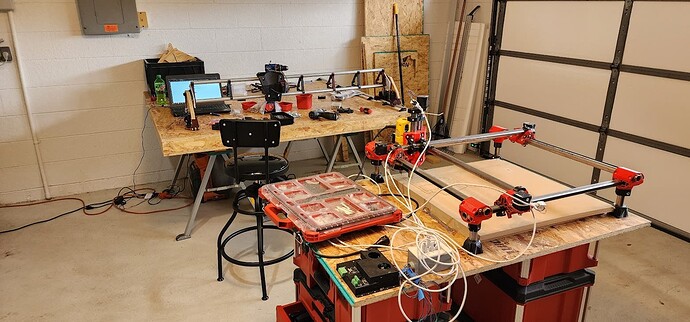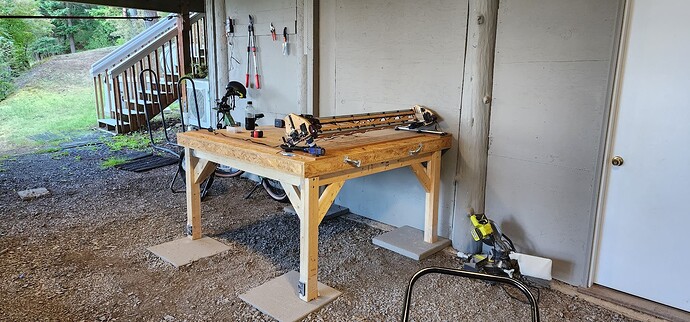What type of wood board is best for a 2’x2’ primo table build that can be bought from most US hardware stores?
Most people use MDF for the top/spoil board. The rest is up to you. I have made plenty of them out of 2x4s. My current full sheet LR3 is on top of cabinets to gain extra storage.
So, 3/4" MDF both for the table and spoil board should be fine? Also, for a simple 2x4 framed table, what height would be good for the legs? Thanks.
That depends on what is comfortable for you. All of my stuff is pretty tall for most. My Grizzly cabinet table saw is sitting on top of 6x6’s to make it taller.
See what heights would be comfortable to you and build it to suit.
Particle board, OSB, and MDF have advantages in being dimensionally stable, and quite flat. Plywood and lumber like 2x4s have a tendancy to warp, making jt a bit trickier to make a flat table.
That said dimensional lumber like me 2x4s can be used as a part of a torsion box with something flat. Drywall is also generally flat, and in conjuctuon with 2x4s makes for a flat torsion box wall. The same can work for a table.
A single piece of MDF can make for a decent temporary platform, and can be put on a more permanent torsion box or reinforced flat table later. I would use lighter material for the torsion box, 1/2" is more than adequate, making the whole thing lighter and cheaper.
Also consider that hollow core doors are good torsion boxes. 2 side by side can give you a good work bench to hold the machine, and can often be had for a reasonable price.
For height, I like to have a comfortable working height. Countertop height is pretty reasonable. I don’t like having to bend over the work, bad ergonomics + power tools = bad things™
Thanks for the advice. So, if using MDF first and then mounting it on a sturdy table later, would you then recommend cutting out the center to be able to replace it as a spoilboard?
You can do that for sure. What I have done on my full sheet LR3 is on top of my cabinets I put a layer of 3/4 MDF, then did a second layer on top of that with one full sheet centered where I thought the LR3 would cut (I was off just a little but doesn’t matter) with the plans of being able to remove just that center sheet and replace as needed. You could do the same idea with your top MDF and just cut inside of where the Primo feet go and have that piece removeable. with your 2’x2’ size you can get multiple layers out of a single sheet and probably still have a replacement spoilboard left over
to give ideas. My temporary mpcnc table while I was building the lowrider v3. Just a flat piece of leftover osb flooring I used for the lowrider table. Doubled up the mdf. The bottom piece got surfaced to make it parallel to the frame, then the spoil board got screwed to that.
Do you think it would be better having the 3/4" 4x8 MDF sheet cut exactly in half to save material and have the flexibility of upgrading the size or better to have the MDF cut exactly around 35"X35" to the outer corners of the feet for a specific 2’X2’ work area as I already cut the tubes for this size?
That depends on your work area. If you have room to fit a 4’ x 4’ table, then that is what I would do for sure. But if you don’t have room for it then build what you need. 2’ x 2’ is pretty much the max you want to go with a primo. but you can put a nice 36" cut width LR on a 4’ wide table ![]()
Thanks, I ended up going the 4’ x 4’ table route. I do have plans to start building a LR3, but I think I saw somewhere that there will be an LR4 release soon. Now, I have to determine what to do about the legs of the table.
I was considering a 2 x 4 simple frame like in the old instructions. I know a premade cabinet or door frame was recommended.
Does anyone have any recommendations for the table legs that would be light, portable, durable, and cost effective?
1x4 pine dimensional lumber glued (and nailed or screwed if you feel the need) in a 90 degree angle makes a light but sturdy leg which is easy to attach to the table top corners and makes it easy to add bracing and shelves partway down the legs.
I’m biased coming from a theater background where “lightweight and portable” were the mantra. I know it’s easy to get and folks are familiar with working with it, but in my opinion 2x4 material is heavier than it needs to be for the sizes of tables folks are building for these CNC machines. Then again, if you don’t need to move it around the extra mass does help absorb vibrations.
I have read in several places that your workbench height should be around the height of your belt buckle. Obviously you can figure out if that suits you, but an easy reference if you are unsure.

